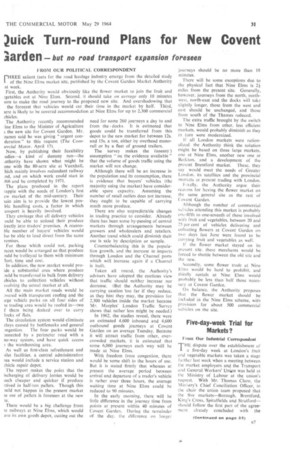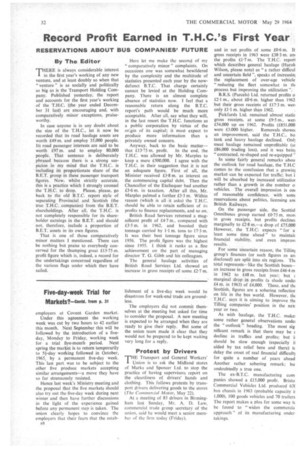2uick Turn-round Plans for New Covent
Page 33

Page 34

If you've noticed an error in this article please click here to report it so we can fix it.
aarden-but no road transport expansion foreseen
FROM OUR POLITICAL CORRESPONDENT
r-HREE salient facts for the road haulage industry emerge from the detailed study L of the Nine Elms market site, published by the Covent Garden Market Authority ist week.
First, the Authority would obviously like the flower market to join the fruit and csetables out at Nine Elms. Second, it should take on average only 10 minutes lore to make the road journey to the proposed new site. And overshadowing that the forecast that vehicles would cut their time in the market by half. Third, 'ere is likely to be covered accommodation at Nine Elms for up to 2,300 commercial chides.
The Authority recently recommended line Elms to the Minister of Agriculture 5 the new site for Covent Garden. Mr. names said he was giving "urgent conderation " to this request (The Cornwrcial Motor. April 17).
Now, by publishing their feasibility .udies—a kind of dummy run—the ,uthority have shown what might be one with the 80-acre site at Vauxhall, .hich mainly involves redundant railway aid, and on which work could start in 966 and be completed by 1971.
The plans produced in the report rapple with the needs of London's first ew market of the mid-century. 'their lain aim is to provide the lowest posble handling costs, a factor in which .ansport is heavily involved.
They envisage that all delivery vehicles .ould be able to unload their produce irectly into traders' premises. A reasonble number of buyers vehicles would [so be able to load direct from the same remises.
For those which could not, parking )aces ,would be arranged so that produce 3uld be trolleyed to them with minimum fort, time and cost.
In addition, the new market would proide a substantial area where produce auld be transferred in bulk from delivery ehicles to collection vehicles without tvolving the actual market at all.
All the main market roads would be 3vered with transparent roofing and the trge vehicle parks on all four sides of ie trading area would be roofed in—two f them being decked over to carry locks of flats.
The circulation system would eliminate clays caused by bottlenecks and general 3ngestion. The four parks would be 3nnected by a perimeter road with a ne-way system, and have quick access ) the warehousing area.
As well as first-class refreshment and Alet facilities, a central administration rea would include a service station and chicle repair depot.
The report makes the point that the ischarging of delivery lorries would be tuch cheaper and quicker if produce rrived in half-ton pallets. Though this 3uld not happen in the present market Se use of pallets is foreseen at the new te.
There would be a big challenge from le railways at Nine Elms, which would ave its own goods depot, cutting out the need for some 260 journeys a day to and from the docks. It is estimated that goods could be transferred from this depot to the new market for between 12s. and 15s. a ton, either by overhead monorail or by a fleet of ground trailers.
The survey makes the (uneasy) ) assumption "on the evidence available" that the volume of goods traffic using the market will not change.
Although there will be an increase in the population and its consumption, there is evidence that buyers' vehicles (the majority using the market) have considerable spare capacity. Assuming the number of retail outlets does not increase, they ought to be capable of carrying much more produce.
There are also unpredictable changes in trading practice to consider. Already there has been some by-passing of central markets through arrangements between growers and wholesalers and retailers. Another trend which could diminish their use is sale by description or sample.
Counterbalancing this is the population growth, and the increase in imports through London and the Channel ports which will increase again if a Chunnel is built.
Taken all round, the Authority's advisers have adopted the cautious view that traffic should neither increase nor decrease. (But the Authority may be carrying caution 'too far if they reduce, as they hint they may, the provision for 2,300 vehicles inside the market because Mr. Marples' London Traffic Survey shows that rather' less might be needed.) In 1962, the studies reveal, there were an estimated 4,600 inbound and 4,600 outbound goods journeys at Covent Garden on an average Tuesday. Because it will attract traffic from other, overcrowded markets, it is estimated that some 6,000 journeys each way will be made at Nine Elms.
With freedom from congestion, there would be some shift in the hours of use. But it is stated firmly that whereas at present the average period between arrival and departure of a trader's vehicle is rather over three hours, the average waiting time at Nine Elms could be reduced to 90 minutes.
In the early morning, there will be little difference in the journey time from points at present within 40 minutes of Covent Garden. During the remainder of the day, the difference on longer journeys should be no more than 10 minutes.
There will be some exceptions due to the physical fact that Nine Elms is 2+ miles from the present site. Generally, however, journeys from the north, northwest, north-east and the docks will take slightly longer, those from the west and east should be unchanged, and those from south of the Thames reduced.
The extra traffic brought by the switch to Nine Elms from other, less efficient markets, would probably diminish as they in turn were modernized.
If all London markets were rationalized. the Authority think the solution might be based on three large markets, one at Nine Elms, another new one at Beaton, and a development of the present Brentford market. These, they say would meet the needs of Greater London. its satellites and the provincial markets at present trading with London.
the Authority argue their reasons for having the flower market on the same general site as the rest of Covent Garden.
Although the number of commercial vehicles attending this market is probably one-fifth to one-seventh of those involved with fruit and vegetables, between 20 and 25 per cent of vehicles delivering and collecting flowers at Covent Garden on two days last June were found to be carrying fruit and vegetables as well.
If the flower market stayed on its present .site, these merchants would be forced to shuttle between the old site and the new.
Secondly, some flower trade at Nine Elms would be hard to prohibit, and thirdly rentals at Nine Elms would probably be less than half those necessary at Covent Garden.
On balance. the Authority proposes that the flower market should be included in the Nine Elms scheme, with provision for about 500 commercial vehicles on the site.
Five-day-week Trial for Markets?
From Our Industrial Correspondent
THE dispute over the establishment of a five-day week at London's fruit Lind vegetable markets was taken a stage farther last week when a meeting between the market employers and the Transport and General Workers' Union was held at the Ministry of Labour at the union's request. With Mr. Thomas Claro, the Ministry's Chief Conciliation Officer, in the chair the union team proposed that the five markets—Borough, Brentford, King's Cross, Spitalfields and Stratford— should follow the first part of the agreement already concluded with the
employers at Covent Garden market.
Under this agreement the working week was cut by two hours to 42 earlier this month. Next September this will be followed by the introduction of a fiveday, Monday to Friday, working week for a trial five-month period. Next spring the market is to return temporarily to 54-day working followed in October, 1965, by a permanent five-day week. This last part was to be subject to the other five produce markets accepting similar arrangements—a move they have so far strenuously resisted.
Hence last week's Ministry meeting and the proposal that the five markets should also try out the five-day week during next winter and then have further discussions in the light of the experience gained before any permanent step is taken. The union clearly hopes to convince the employers that their fears that the estab R8 lishment of a five-day week would be disastrous for week-end trade are groundless.
The employers did not commit themselves at the meeting but asked for time to consider the proposal. A new meeting is expected to be arranged when they are ready to give their reply. But some of the union team made it clear that they would not be prepared to be kept waiting very long for a reply.
Protest by Drivers THE Transport and General Workers' Union is to ask the Midland stores of Marks and Spencer Ltd. to stop the practice of having supervisors report on the cleanliness of drivers' hands and clothing. This follows protests by transport drivers delivering .goods to the stores (The Commercial Motor, May 22). At a meeting of 85 drivers in Birmingham last Sunday, Mr. A. D. Law, commercial trade group secretary of the union, said he would meet a senior member of the firm today (Friday),




















































































































